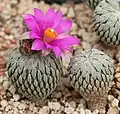| Pelecyphora aselliformis | |
|---|---|
 | |
| Scientific classification | |
| Kingdom: | Plantae |
| Clade: | Tracheophytes |
| Clade: | Angiosperms |
| Clade: | Eudicots |
| Order: | Caryophyllales |
| Family: | Cactaceae |
| Subfamily: | Cactoideae |
| Genus: | Pelecyphora |
| Species: | P. aselliformis |
| Binomial name | |
| Pelecyphora aselliformis C.Ehrenb. | |
| Synonyms | |
| |
Pelecyphora aselliformis is a species of Pelecyphora found in Mexico. Pelecyphora aselliformis is known for its medicinal properties and may have been utilized as a psychoactive in the same way as Lophophora williamsii. It is known as "Peyotillo".[2]
Description
Pelecyphora aselliformis grows with globose, spherical or flattened spherical grayish green stems, with fleshy roots that are 2 to 7 centimeters in diameter and about 12 cm high. Their hatchet-shaped tubercles are 2 to 4 millimeters high, 5 to 9 millimeters long and 1 to 2.5 millimeters wide. Its outer part is flattened and the outline is elliptical. The areoles are woolly, 40 to 60 stiff, whitish spines are arranged in a striking comb-like manner and are 0.7 to 4 millimeters long. The magenta-colored flowers appear at the apex, between the wooliness of the young areole reach diameters of 1.3 to 3.5 centimeters.[3]
It grows very slowly and flowers only after many years.
Distribution
Pelecyphora aselliformis is widespread in the Mexican state of San Luis Potosí. It inhabits low hills and flat plains at elevations of 1800 to 2400 meters and grows on nutrient-rich, dark soils and limestone rocks. The range extends over an area of no more than 500 km2.
Taxonomy
The first description was made in 1843 by Carl August Ehrenberg.[4] The specific epithet aselliformis means 'woodlouse-shaped'. Common names are “Peoti”, “Peotillo”, “Peyote” and “Peyotillo”.
When a new highway was built north of the city of San Luis Potosí that passed through a population of Pelecyphora aselliformis, 1226 specimens of the species were relocated to the El Charco del Ingenio Botanical Garden near San Miguel de Allende.[5]
References
- ↑ SG), Succulent Plants; SG), Succulent Plants (2009-11-16). "The IUCN Red List of Threatened Species". IUCN Red List of Threatened Species. Retrieved 2023-10-20.
- ↑ Bruhn, Jan G.; Bruhn, Catarina (1973). "Alkaloids and ethnobotany of Mexican peyote cacti and related species". Economic Botany. 27 (2): 241–251. doi:10.1007/BF02872994. ISSN 0013-0001.
- ↑ Anderson, Edward F.; Eggli, Urs (2005). Das grosse Kakteen-Lexikon (in German). Stuttgart (Hohenheim): Ulmer. p. 521. ISBN 3-8001-4573-1.
- ↑ Mohl, Hugo von; Schlechtendal, D. F. L. von (1843). "Botanische Zeitung". A. Förstner. Retrieved 2023-10-19.
- ↑ Glass, Charlie; Maurice, W.A. Fitz (1993). "To The Rescue!". British Cactus & Succulent Journal. British Cactus and Succulent Society. 11 (2): 47–51. ISSN 0264-3405. JSTOR 42794389. Retrieved 2023-10-20.
External links
 Media related to Pelecyphora aselliformis at Wikimedia Commons
Media related to Pelecyphora aselliformis at Wikimedia Commons Data related to Pelecyphora aselliformis at Wikispecies
Data related to Pelecyphora aselliformis at Wikispecies






